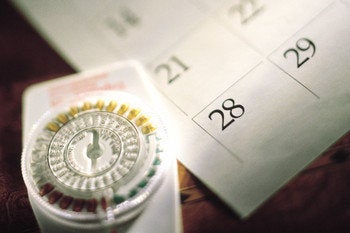
In this week's New York Times, Andrew Sullivan reported on the highly disturbing fact that in the past five years, more than a fifth of the country's 54,700 water treatment systems have violated major provisions of the Safe Drinking Water Act, with no follow-up fines or punishment by either the state or the EPA. Thanks in large part to a decade of nearly nonexistent enforcement, tens of millions of men, women and children now routinely drink, bathe in and cook with tap water laced with illegal levels of contaminants (not just bacteria, parasites and viruses, but known carcinogens like arsenic, uranium, radium, and tetrachloroethylene). Nice, huh? Even at a time when we as a country can't agree on a fundamental right to health care, is there anyone who doesn't believe in the right to free, potable water that won't potentially kill you?
Having just co-written a book about menstruation, I'm reminded of yet another lovely variation on the water pollution theme, one that's directly related to women's health and the choices we make as consumers. In recent years, there have been increasing reports about "intersex" animals that live in or near the water: male alligators with undersize penises, male fish that produce eggs as well as sperm, male sea birds with female traits. If you've been wondering about the dying-off of wild salmon populations in the Pacific northwest, look no further; increasingly, scientists are laying the blame on estrogen. Certain pesticides and compounds (the kinds commonly found in many cleaning agents, skincare products, and plastics) can mimic the actions of the potent female hormone; and these pollutants are routinely dumped, drained, washed off and released into our waterways every day in vast quantities. Even incredibly small traces of these compounds can induce partial sex changes in salmon, changes that ultimately affect the number of females born and eventually the overall population.
Obviously, much of this pollution occurs as a result of routine manufacturing and commercial farming. Yet we can't ignore the fact that another potent source of estrogen pollution in our water comes from our love of the Pill - next to condoms, the most popular form of birth control in the United States. More than 100 million women worldwide currently rely on the Pill for its relative effectiveness, its convenience, and the fact that it reduces one's period to a highly manageable and predictable monthly event. The unseemly downside, however, is that together, Pill users excrete vast amounts of leftover synthetic estrogen every day. The estrogen isn't completely broken down during sewage treatment; what's more, some scientists believe it may even be reactivated by bacteria during the process. Vast amounts of estrogen then go surging into rivers and streams, affecting every animal that lives there and accumulating in their bodies... including those of the fish we eat.
You can also add to the mix the new "menstrual suppression" drugs that are currently being marketed to young women, mostly through the re-branding menstruation as an annoyance to be contained or even eliminated outright (i.e. why let your monthly blood interfere with that hot date or your yoga class?). Menstrual suppression drugs are pretty much birth control pills in a new wrapper, only minus the placebo week that gives Pill-users that paltry week of phony flow; and if they catch on, they too will add to the excessive load of estrogen being pumped into our rivers, streams and lakes.
So how much of an immediate health risk is any of this? Unfortunately, it's hard to tell; so many diseases like cancer often take years to develop and it can be difficult to identify the smoking gun. Yet one thing is clear: breast and other cancer rates have risen over the past 30 years, and research indicates they may well be tied to pollutants like those found in our drinking water. Knowing that the pill you pop may well end up the estrogen-laced water you drink shouldn't be the only factor to take into account when making choices about birth control; but it's nevertheless one well worth considering.